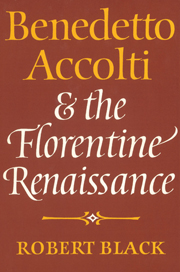Book contents
- Frontmatter
- Contents
- Dedication
- Preface
- Abbreviations
- 1 Arezzo in the early Renaissance
- 2 The Accolti family
- 3 Benedetto Accolti's early life and works
- 4 Accolti in Florence and Arezzo in the 1440s and early 1450s
- 5 Accolti's election as chancellor of Florence
- 6 The Florentine chancellorship
- 7 The Florentine chancery under Accolti
- 8 Accolti's Dialogus
- 9 Accolti's history of the first crusade and the Turkish menace
- 10 Accolti and Renaissance historiography
- Epilogue
- Appendix I Letters of Benedetto Accolti
- Appendix II Accolti's work as a palace official during his chancellorship
- Appendix III Pratica concerned with increasing Accolti's salary as chancellor
- Appendix IV Accolti and the incident of Ponzano, July–August 1463
- Select bibliography
- Index
6 - The Florentine chancellorship
Published online by Cambridge University Press: 12 October 2009
- Frontmatter
- Contents
- Dedication
- Preface
- Abbreviations
- 1 Arezzo in the early Renaissance
- 2 The Accolti family
- 3 Benedetto Accolti's early life and works
- 4 Accolti in Florence and Arezzo in the 1440s and early 1450s
- 5 Accolti's election as chancellor of Florence
- 6 The Florentine chancellorship
- 7 The Florentine chancery under Accolti
- 8 Accolti's Dialogus
- 9 Accolti's history of the first crusade and the Turkish menace
- 10 Accolti and Renaissance historiography
- Epilogue
- Appendix I Letters of Benedetto Accolti
- Appendix II Accolti's work as a palace official during his chancellorship
- Appendix III Pratica concerned with increasing Accolti's salary as chancellor
- Appendix IV Accolti and the incident of Ponzano, July–August 1463
- Select bibliography
- Index
Summary
The chancery of the Florentine commune was divided into a number of sections. One of these was headed by the notary of the Riformagioni, who was in charge of recording the results of meetings of the ancient legislative assemblies and of drafting the legislation approved by these assemblies. Another section was headed by the chancellor himself, whose functions were quite distinct from those of the notary of the Riformagioni; indeed, the chancellor was never head of the entire chancery, the section headed by the notary of the Riformagioni remaining autonomous throughout the life of the Florentine republic. The traditional duty of the chancellor was to compose letters on behalf of the commune and to write the commissions and instructions of communal ambassadors. In a rubric of the earliest extant compilation of Florentine statutes, the Statutes of the Podestà of 1325, it was required that each year an experienced notary from the Florentine guild of lawyers and notaries should be elected chancellor of the commune by the Signoria and colleges; he was to serve as ‘dictator of letters and embassies’ for the commune and the Signoria, and perform all the duties of the chancellor. The chancellor, however, was never in charge of all the business and correspondence of the Signoria. Frequently orders, warrants or announcements were despatched in the name of the Signoria itself rather than of the commune as a whole and were therefore drawn up by the Signoria's own notary, the notary of the Signoria, who, as head of a third autonomous section of the chancery, was responsible for the day-to-day deliberations and business of the Signoria.
- Type
- Chapter
- Information
- Benedetto Accolti and the Florentine Renaissance , pp. 115 - 137Publisher: Cambridge University PressPrint publication year: 1985



